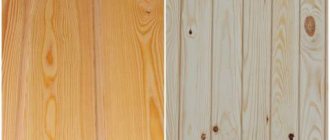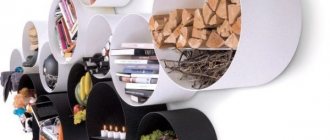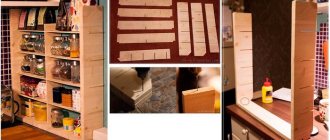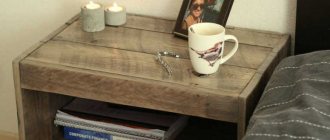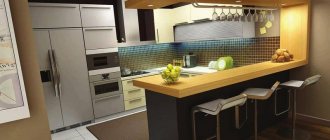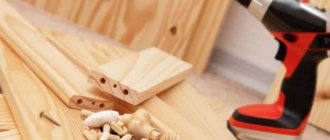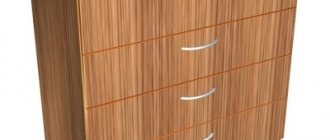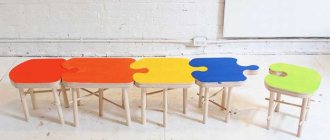When working with papers at home, and even more so in the office, there is often a need to organize storage for folders, files, and office supplies. And it often happens that there is simply no room in the room, except in the inner space of the table, for this. A roll-out cabinet with drawers under a desk will help solve the problem. You can, of course, buy a finished product if you can find the right size, or you can, if you wish and have the necessary tools, make it yourself. This is where we will try to help you.
Roll-out cabinet with drawers for desk
Scheme and sequence of work
Regardless of the chosen furniture model and the place of purchase of the kitchen set, the furniture will be delivered to the house or apartment in the form of packages packed in paper, laminated panels, boxes with fasteners and furniture fittings. In fact, assembling a kitchen set begins with a thorough inspection and counting of all delivered packages, checking for scratches and damage and the completeness of all parts. As a rule, the kitchen set includes:
- Packages with side walls, shelves and doors of cabinets of the lower tier of furniture;
- Kits for assembling lower tier drawers are supplied separately;
- Panel kits for assembling and installing the upper tier of wall cabinets;
- Sets of canopies, handles, support slides, door closer parts and door closing shock absorbers sealed in polyethylene.
Before assembling the kitchen set, it is necessary to sort and arrange the bags with fasteners and accessories into packs with packaged laminated panels. This will avoid fastener loss, confusion, and improper use.
Most manufacturing companies mark the packages, and in the summary sheet for the kitchen set they indicate information about the belonging of a particular package with accessories to a specific kit for assembling a cabinet. This greatly simplifies the preparation for assembling the kitchen set with your own hands.
Assembly of the structure
Having correctly completed all stages of the work, you will have at your disposal a durable, beautiful cabinet in which you can store anything you want if you wish. Having prepared the workplace, you can begin work, which consists of the following stages:
- If you did not use the help of specialists to manufacture the parts, then before starting assembly, glue the ends of all blanks with a special edge tape. To fix the tape better, run a moderately heated iron over the pasted surface. Cut off the excess parts of the tape with a knife, and sand the edges of the part with sandpaper.
- Assemble the body of the cabinet using corners and woodworking screws. When installing each new part, measure the perpendicularity of the structure in order to get a high-quality result from the work performed.
- Guided by the proposed diagram (Figure No. 1), assemble each box. To install the comfirmats, make a hole 0.8 cm in diameter in the plane of the part. The diameter of the holes in the end part of the workpiece should be 0.5 cm.
- Make markings for attaching the guides. This work should begin from the top of the cabinet body, taking into account the height of the drawer and the required gap (3mm).
- Using pre-made markings, secure the guides on the inside of the sides of the cabinet. To do this, simply divide the device into two halves. Install the wide parts of the guides on the walls of the cabinet, and the narrow parts on the surface of the sides of each drawer. You can find out how to properly disassemble the mechanism for installing drawers from the seller of this spare part or by reading the manufacturer’s instructions.
- Installation of the guides should be carried out with a distance of at least 3 mm from the front end of the housing. This way, you will ensure that each drawer opens completely and all mechanisms work properly.
- The last stage of assembly is the installation of drawer fronts and fittings. In order to carry out such work correctly, make marks in advance at the fastening points and only after that drill the holes.
- All visible fastening points can be closed using special plastic plugs of the most suitable shade.
Fig No. 1. Drawer assembly diagram
Kitchen set assembly sequence
There are no strict instructions on the order in which the work should be performed; there are manufacturer’s recommendations and a flow chart describing how to assemble a kitchen set with your own hands at the most difficult stages of assembly work. If the installation of kitchen furniture in the kitchen is carried out by a team of several people, work on assembling the set can be carried out simultaneously for the upper and lower tier of cabinets.
The only condition that must be observed is the sequence of installation of the assembled kitchen cabinets on the prepared area in the kitchen:
- The top tier of cabinets and drawers are hung first; if a corner kitchen set is to be assembled, then the installation process first begins with the installation of a cabinet located in the common corner of the set;
- The second stage is the installation of the lower tier, cabinets and cabinets are connected with through fasteners, drawers and pencil cases are installed;
- The third stage is laying the countertop set, installing ovens and hobs, sinks and mixers.
One of the most common defects in hasty assembly and installation of kitchen units is the formation of gaps between the walls of wall cabinets. This is usually due to either crooked or insufficiently rigid kitchen walls, or inaccurate assembly of the kitchen cabinets themselves. The formation of cracks is especially noticeable in corner cabinets. Therefore, the craftsmen recommend that before assembling the kitchen corner set on the kitchen wall, try on and adjust the joints on the cabinets in the corner of the room.
For your information! To ensure the correct assembly and installation of the upper tier of the set, the hanging cabinets are loaded with the working weight of dishes and kitchen utensils.
If the weight of the load between the hung cabinets does not increase the gaps, you can tighten the upper tier of the set with through fasteners and proceed to installing the lower tier of kitchen furniture.
Preparation for work on assembling the cabinet with guides
The instructions below describe the process of assembling a cabinet with guides, the overall dimensions of which are 85X40X50cm. The design of this piece of furniture consists of five drawers of the same size. The dimensions of the front of each drawer are 14x39.7 cm.
In order to significantly simplify the work, lumber can be sent to the nearest carpentry shop for sawing. Following your calculations and the proposed drawings, specialists will manufacture all the elements of the cabinet for you, and also treat their ends with high-quality self-adhesive edging tape. As a result you will get:
- Front part of the box (14X39.7cm) – 5 pieces;
- Drawer sides (11X45cm) – 10 pieces;
- Front and back walls of drawers (11x31cm) - five pieces each.
To start assembling the structure, you will need a relatively small set of tools, which includes:
- Powerful screwdriver or drill;
- Drills for woodworking (5 and 8 mm);
- Screwdriver bits;
- Hex bits for furniture screws;
- Roulette; ruler or small building level;
- Square and pencil;
- Knife;
- Sandpaper of different fractions.
When choosing guide elements, give preference to roller-type mechanisms. They are not very cheap, but they last a long time. Such fasteners are not distinguished between right-handed and left-handed. You need to buy ten pieces of roller guides 45 centimeters long. In addition, for high-quality assembly of the cabinet you will need:
- Self-tapping screws for woodworking (4X16mm and 4X30mm);
- Furniture screws (5X70);
- Five furniture handles for drawers.
Return to contents
Lower tier cabinets
The most difficult stage of installing kitchen furniture is traditionally considered to be the assembly of cabinets with drawers, so before you rush to study the instructions on how to install a kitchen set, you will need to stock up on useful tools:
- Electric screwdriver with a set of conventional and carpentry tubular drills;
- Construction level, carpenter's corner, tape measure, set of clamps;
- A wooden strip or glazing bead for cutting mounting plugs, a tabletop electric sharpener.
It may seem that the given set looks quite unusual, like for assembling kitchen furniture with your own hands, but this is a deceptive impression. Kitchen sets made of fiberboard or chipboard, solid wood, have always been assembled on wooden pins or dowels; sometimes the grooves and pin tenons do not match or break during assembly and installation.
Therefore, you have to drill new holes, grind out additional sets of tenons and join the bodies of kitchen cabinets, and only then screw furniture screws into the parts of the set.
Many kitchen furniture manufacturers offer to assemble furniture cabinets and cabinets using steel corners and clips. One of the options for such a DIY kitchen set assembly is shown in the video. This is the cheapest, but not the best technology.
Completion of the assembly stage
The principle of assembling the cabinet itself is not very different from making a drawer. The sides and rear wall are attached to the bottom in the same way. The front walls of the drawers will form the façade - these are what we will be installing now. To do this, the body of the cabinet must be assembled without the back wall, and the drawers must be put in place.
Table 3. Assembly
| Steps, photo | A comment |
Step 1 - Assembling the Case | Once all the drawer slides are installed, you can assemble the box pieces together. The connection is made on confirmations. |
Step 2 - Installing the Drawers | Place drawers without fronts in their regular places and check that they slide out easily. |
Step 3 — Marking the façade for drilling holes for the eccentric | Now you can start hanging the front strips on the drawers. Place the workpiece face down, and use a square to determine the points for fasteners. |
Step 4 - Marking the future hole with an awl | Punch the hole with an awl over the pencil mark. |
Step 5 - Drill the holes | The holes are drilled blind, the diameter should correspond to the diameter of the tie, and the depth should correspond to the length of its thread. |
Step 6 - Screw in the eccentrics | The ties are screwed into the holes on both sides up to the limiter. |
Step 7 – Putting the Drawer Front in Place | The eccentric legs are aligned with the holes in the ends of the side walls of the box, and the front strip is installed in its place. |
Step 8 - installing the eccentric head into the hole | Next, eccentric heads are placed in the wide side holes... |
Step 9 - Tightening the Connection | ... after which they need to be tightened with a screwdriver. |
Step 10 - Install the fittings | Install all the fronts on the drawers in the same way, mount the back wall - and, in principle, your cabinet is ready. |
Prices for cordless screwdrivers
Cordless screwdriver
Attention. Do not forget that before starting assembly, the ends of all workpieces must be covered with melamine edge. It is sold already with an adhesive layer; all you have to do is apply it to the cut and iron it with a hot iron.
In conclusion, all that remains is to screw the wheels to the bedside table - to make it convenient to move it, and install the handles on the drawers. If desired, the perimeter of the product body can be decorated with a wooden baguette or polyurethane molding.
Small-sized apartments exist not only in old Khrushchev-era buildings; completely new housing projects, designed for the poorer category of our fellow citizens, also save on passerby space. The industry takes into account the situation in the housing market and produces small-sized but very functional furniture specifically for such situations. In a special article you will find tips on choosing a cabinet for a small hallway, as well as instructions for assembling a door cabinet.
Video - How to make a cabinet with drawers
Lower tier cabinet with door
First of all, the selected parts of the future cabinet are laid out on a clean and dry surface of a sheet of chipboard or plywood laid on the floor. An example of such a kitchen set assembly is shown in the video.
Assembly operations are performed virtually on the floor, that is, the kitchen cabinet is laid on the back side and assembled from start to finish, remaining in a horizontal position. This is why it is important that the base of the floor is perfectly flat.
The cabinet is assembled in the following order:
- From the unpacked kit, select the panel with two milled holes for the cabinet. This is a door, and the holes are made as sockets for installing door hinges;
- We install the hinges, level and fix the canopies using self-tapping screws. Next, we attach the door to the wall and transfer the markings of the canopies onto it. We are not attaching the door itself yet; you just need to install the canopy's counterparts on the cabinet wall using the markings;
- Next, we install wooden dowels in the holes of all four walls, and connect the panels into one body of the future cabinet. If there are no comments on the quality of the joining, you can disassemble and install the dowels with glue, preferably PVA or any polyurethane compound;
- While the glue dries, the body is turned over and, using a carpenter's corner, leveled so that all angles are 90°, after which a thin back wall made of DFP or plywood is stuffed onto the back side.
Once the glue has dried, you can install and secure the cabinet front door. Furniture canopies are pre-aligned and adjusted so that the side end of the door is in line with the cabinet wall.
The final part of the assembly and installation of any element of kitchen furniture is the installation or tightening of furniture screws. It is enough to mark the installation point, drill it with a thin drill to a depth of ¾ of the length of the fastener and screw the self-tapping screw into the end of the wall using a screwdriver with a hexagon installed.
All cabinets with doors are assembled in a similar way, regardless of which tier of the kitchen set they belong to. The only difference is that plastic legs or racks need to be installed on the cabinets of the lower tier, and steel hanging hinges are attached to the back of the wall cabinets of the upper row.
Advice! If possible, it would be a good idea to purchase one set of furniture canopies in stock. As a rule, standard hinges are enough for 3-5 years of intensive use of the cabinet.
What you will need to make a cabinet from chipboard with your own hands
Before you start making a bedside table for a TV, an aquarium, a hallway, a bedroom or a children's room, it is important to calculate all the costs. It is quite possible that in the end it will be more profitable to buy some ready-made option than to do it yourself. Custom production always costs more.
Sheet materials
As has already been calculated, for the bedside table you will need a sheet of chipboard, which needs to be cut into pieces. And they, in turn, should be edged. I always recommend using cutting and edging services at the place where you purchased the material. It’s easier to pick up parts already cut to size in a passenger car than to decide how to transport and bring in a sheet of chipboard, than to saw and edge it.
You will also need fiberboard for the back wall and drawer bottoms.
Accessories and hardware
You can read more about what fittings and fasteners are used to assemble cabinet furniture here.
To assemble the frame of the chipboard cabinet in the drawing with your own hands, you will need the following fasteners (hardware):
To install drawers, shelves, fronts and other parts of the bedside table you will need the following fittings:
Hand tool
The set of hand tools will vary somewhat depending on what work you plan to do yourself and what to delegate.
- To cut chipboard by hand you will need at least a jigsaw and a grinder.
- To glue the melamine edge yourself, you will need an iron, a utility knife to cut off the excess after gluing, and fine sandpaper to sand the edge. I always recommend buying a couple of meters of melamine tape in reserve to match the color of the chipboard. It happens that the workshop “misses” or confuses the sides of the pasting (rarely, but nonetheless). In order not to fuss with such a defective part and not to interrupt the assembly process, it’s faster to glue it yourself.
- To drill the assembly holes, you will need an electric drill and a confirmation drill (or a 5mm drill for drilling the ends separately and 8mm for the front sides). More details about drills here, for different types of fasteners, as well as installation of hinges. You will also need a pencil, tape measure, and a square for marking.
- For assembly you will need a screwdriver or ratchet, a screwdriver and bits for self-tapping screws.
Find out more about hand tools for making and assembling cabinet furniture here.
Assembling a cabinet with drawers
Assembling and installing a cabinet with drawers is a little more labor-intensive. Today, in almost any model of kitchen set, cabinets with drawers remain one of the most popular furniture elements.
The first part of the installation process, namely, assembling the cabinet body is no different from the gluing scheme of the cabinet body with the door. The only difference is that the cabinet does not have a door, there is only a facade formed by a vertical row of front panels of drawers.
Step one, installing the drawer slides
To install each drawer, you will need to attach a pair of guide slides and one plastic closer strip to the inside of the cabinet body. You can install drawers without a closer, but using the lower tier of the kitchen set is much more convenient if the design has a finishing mechanism.
First you will need to draw the skid mounting lines. This can be done using a regular building level, the main thing is to maintain the horizontal direction of the marking. The gaps between the supporting surface of the guide slides and the rollers of the drawers are large enough, so that if a small error is made during fastening, this fact will not particularly affect the quality of installation and functioning of the sliding parts of the kitchen set.
The closer design consists of a hinge that will need to be installed on the side of the drawer, and a small plastic mechanism that is attached just below the guide slide.
Step two, assembly and installation of boxes
The drawer is made of two sides, a back strip, a wooden bottom and a front panel. The first three elements are attached to the bottom with ordinary self-tapping screws, resulting in a wooden box without a front wall. Sidewalls are usually made of metal or plastic, with support rollers installed on each side.
All that remains is to correctly install the front panel for each drawer separately.
The main difficulty is to install the front panel exactly according to the profile of the cabinet, so that the front part of the lower tier of the set looks as even and symmetrical as possible.
To install the facade panel, we use two metal fasteners, first transfer the markings from the box to the inside of the laminated board and screw the “pieces of iron” with ordinary self-tapping screws.
The last step is to adjust the position of the panel in such a way as to ensure a small gap of 1.5-2 mm between the drawers and align the façade panel as accurately as possible along the line of the future countertop. To do this, use additional adjustment screws located on the metal corner mount.
The principle of assembling the box
A box without a front element, which is assembled first, consists of a bottom with three walls screwed to it. In factory cabinets, the bottom is made of hardboard (hard fiberboard). This material is chosen not because it is better, but because it is cheaper in mass production.
1. When working independently at home, it is much more convenient to use the same material for making the bottoms as for the walls - 16 mm thick laminated chipboard. One sheet, the area of which is about 4 m², is enough for the entire bedside table.
Drawer body
Fastening the side walls of the box with confirmations
Fastening the facade to an eccentric screed
2. Such thick sheet material is used to ensure that the connections of perpendicularly located elements, which are made on confirmations, are as strong as possible.
3. Confirmats are so-called euroscrews with zinc coating, which have a blunt shaft at the end and a countersunk head. These hardware are very convenient because they do not require scrupulous precision markings.
Note. Although the confirmations go into hiding, the places where they are installed remain visible. This is unacceptable for facades, so for their fastening you should use eccentric ties, for which you need to very accurately mark.
See below for how this is done.
Connection details
For clarity, we offer instructions in pictures, and we will mention the necessary tool during the comments.
Table 1. Assembling boxes
| Steps, photo | A comment |
Step 1 — Device for marking under the screed | For accurate marking and drilling for the eccentric, it is necessary to use a special jig. |
Step 2 - Marking for fastening | Taking into account the size of the fastener and the location of the hole for it, markings are made using a square. |
Step 3 - The principle of working with the conductor | Having made a mark at the required distance from the edge of the workpiece, place the jig on it and align the tip of the triangular pointer with the pencil mark. |
Step 4 - Drilling the End Hole Through the Jig | Holding the jig firmly in a given position, drill from the end side of the facade part through a hole specially designed for this purpose. |
Step 5 - Marking the Second Hole | Now insert a drill bit into this hole to center it. Take an awl, and through the marking holes in the jig, mark a point for drilling on the rear plane of the drawer front. There are several such holes on the jig, the choice of the desired one is made in accordance with the length of the eccentric leg. |
Step 6 - Drilling a hole for the eccentric head | A blind hole with a diameter of 15 mm is required for the eccentric head, for drilling which you need a wood cutter (Fostner drill). |
Step 7 - Installing the Cam in the Hole | The eccentric head can be easily inserted into the resulting wide hole, and its rod will be inserted into the side hole. In this way, parts for all boxes are prepared, after which you can begin assembling them. |
Step 8 - Back Wall First | The bottom is placed on the table, and the back wall is screwed to it first... |
Step 9 — Jig for drilling holes for fasteners | ...then the side ones. To mark the drilling sites for fasteners, you need a different type of jig (you can see it in the photo), but the principle of working with it is still the same. |
Step 10 — Attaching the back wall to the confirmat | The fastening of one rear and two side walls is carried out using European screws. |
Step 11 - Attaching the Side Wall | Screw in the confirmations using a screwdriver. |
Step 12 - This is what the finished box will look like | After attaching the walls, all that remains is to screw on the facade. But this is done after all the drawers without front walls have been installed in the cabinet body. For now, just a fitting. |
Prices for cordless drill/driver
Cordless drill/driver
The next stage is the installation of running gears.
Installation of guides
It is better to assemble the cabinet body and install roller mechanisms on the racks after all the drawers are ready. After all, your production is not mechanized, and there may well be errors in size. Therefore, the drawing is a drawing, and markings on the racks for fastening the runners must be done by measuring the height of the front elements of the boxes in fact.
Table 2. Installation of guides
| Steps, photo | A comment |
Step 1 – trying on the video | We decide on the position of the running mechanisms, which can be either from the bottom of the side wall of the box, or from the top or in the center. |
Step 2 – marking on the drawer for the guide | Make markings on the side of the box. |
Step 3 – marking for drawers on the side of the cabinet | Mark the distances between the rollers on the stands of the cabinet. |
Step 4 - continue marking | Draw the installation lines for the reciprocal part of the roller mechanism. |
Step 5 - Disassembling the guide into two parts | The roller mechanism consists of two parts, which are disconnected from each other by pressing the lever. One part is attached to the drawer, the other to the stand of the cabinet. |
Step 6 - Marking the Rail Attachment Points | Apply the guide to the marking site, and mark the attachment point in the center of the hole, first with a pencil, then with an awl. |
Step 7 - Fixing the chassis with screws | Apply the screw and tighten it. Then similarly fasten the counter parts of the runners to the sides of the drawers. |
Note. The guides are attached through oblong vertical holes.
Which hole to mount it in?
We assemble the upper tier
Before hanging wall cabinets and shelves, you will need to do two small preparatory steps. Firstly, it is necessary to draw a marking line on the wall along which the upper tier of the headset will be installed, and secondly, lay wiring in the wall to which the hood and lamps will be connected.
The upper tier of kitchen cabinets can be attached in two ways:
- Hanging on metal hinges attached to the back of each cabinet;
- Direct fastening with self-tapping screws through plastic “ears” - hangers installed on the inner surface of the vertical walls of wall boxes.
The first option is much simpler, as it does not require special skills in working with furniture. It is enough just to install hanging dowel hooks according to the completed markings. When installing the cabinet on built-in hangers, anchor studs are sealed into the kitchen wall, after which the cabinet is inserted onto them and the plastic hanger is tightened so that the entire structure of the set fits as tightly as possible to the kitchen wall.
Subtleties of the lower tier assembly process
After all the cabinets and cabinets of the kitchen set have been assembled, we proceed to installing the lower tier on the prepared kitchen area. First, you need to move all the cabinets and bedside tables to the installation site and place them in the same plane so that the distance from the facade to the wall surface is within 50-55 cm.
At the second stage, a rough adjustment of the height of the working surface is performed. For this, height-adjustable legs of a bedside table or cabinet are used. By rotating the screws, we ensure that the upper plane of each cabinet or cabinet is aligned in height and horizon. After leveling, all components of the lower tier are pulled together with through fasteners into one rigid monoblock.
Tabletop installation
As a rule, the kitchen countertop is assembled from two separate parts, joined in a corner or in the area where the hob is installed. The same wooden pins and glue are used to secure the tabletop. Initially, holes for dowels are marked and drilled in the upper part of the installed cabinets. Next, install the pins into the holes, after which the fasteners are carefully pressed down with light blows with a wooden hammer. Using a ruler, a building level and a sharp knife, the upper parts of the pins are cut so that their ends are at the same height and in the same plane.
At the next stage, it is necessary to determine the exact position of the tabletop on the base of the lower tier. To do this, apply bright paint to the ends of the cut pins and lay the countertop slab exactly as it should be located according to the diagram for the kitchen unit. Using the paint imprints on the back side of the slab, blind holes are drilled and it is re-applied onto the pins. After the countertop is in place, mark the cut-out holes for installing the sink and hob.
For the final installation of the countertop, the pins and the top of the cabinets are glued with silicone or polyurethane glue, after which they are installed in place and evenly loaded with pressure. The edge of the junction with the wall apron is sealed with a plastic profile made of transparent silicone.
Step-by-step instructions for making a bedside table
Stage 1. Frame assembly
Important! First you need to develop drawings of the cabinet, which will be needed at each stage of manufacturing.
We drill holes in the panels and frame supports. We lay the side panel on a plane and fasten it to the boards with screws.
We make holes for the drawers. We install and strengthen the base of the cabinet and the second panel.
Stage 2. Installing the bedside table cover
We fix the lid of the cabinet with screws L - 4 cm. Then we cut two dowels at 45 degrees and glue them to the frame with wood glue and wait for it to dry completely. Drying time is indicated on the packaging.
Fill the gaps around the dowels with acrylic sealant. The frame of the wooden cabinet with your own hands is ready.
Stage 3. Installation of guides
To install guides for drawers, we apply markings on each side and under each drawer.
Using a screwdriver, secure the guides to the side panels.
Stage 4. Assembling the parts of the boxes
Before assembly, we clean the parts of the drawers first with coarse-grained sandpaper, and then with fine-grained sandpaper.
Stage 5. Installation of fittings
We screw a handle onto each drawer. A photo of a DIY cabinet can be seen below.

